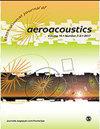Ffowcs Williams – Hawkings analogy for near-field acoustic sources analysis
IF 1.3
4区 工程技术
Q3 ACOUSTICS
引用次数: 0
Abstract
The paper expands the scope of applying the Ffowcs Williams – Hawkings integration method. We propose using the acoustic field generated from time-dependent data stored on the FW-H control surface as the same common field for computational acoustic beamforming and dynamic mode decomposition methods to analyze the aerodynamic noise sources. We exemplify that it leads to obtaining mutually consistent and complementary information for reliable prediction of acoustic sources characteristics in the process of inverting data produced by a CFD simulation. Moreover, as the results of applying computational acoustic beamforming and dynamic mode decomposition methods depend on many geometric and algorithmic inputs, the proposed approach makes it possible to use various sets of the latter for a comprehensive analysis of obtained inversions and to form the final answer by an averaging procedure. We illustrate this by taking advantage of fast generating the examined acoustic field snapshots in any required region by the FW-H integration method for the recently developed new inverse computational acoustic beamforming algorithm and the standard dynamic mode decomposition method when carrying out a sensitivity study of the predicted acoustic source. The capabilities of the developed approach are demonstrated on the data of CFD scale-resolving simulation of turbulent flow over the 30P30N high-lift configuration.近场声源分析的Ffowcs Williams - hawkins类比
本文扩展了Ffowcs-Williams–Hawkings积分方法的应用范围。我们建议使用由FW-H控制表面上存储的时间相关数据生成的声场作为计算声学波束形成和动态模式分解方法的相同公共场来分析空气动力学噪声源。我们举例说明,在反演CFD模拟产生的数据的过程中,它可以获得相互一致和互补的信息,从而可靠地预测声源特性。此外,由于应用计算声学波束形成和动态模式分解方法的结果取决于许多几何和算法输入,因此所提出的方法可以使用后者的各种集合来对所获得的反演进行综合分析,并通过平均程序形成最终答案。在对预测声源进行灵敏度研究时,我们利用最近开发的新的反向计算声波束形成算法的FW-H积分方法和标准动态模式分解方法在任何需要的区域快速生成检查的声场快照来说明这一点。所开发的方法的能力在30P30N高升程配置湍流的CFD尺度解析模拟数据上得到了证明。
本文章由计算机程序翻译,如有差异,请以英文原文为准。
求助全文
约1分钟内获得全文
求助全文
来源期刊

International Journal of Aeroacoustics
ACOUSTICS-ENGINEERING, AEROSPACE
CiteScore
2.10
自引率
10.00%
发文量
38
审稿时长
>12 weeks
期刊介绍:
International Journal of Aeroacoustics is a peer-reviewed journal publishing developments in all areas of fundamental and applied aeroacoustics. Fundamental topics include advances in understanding aeroacoustics phenomena; applied topics include all aspects of civil and military aircraft, automobile and high speed train aeroacoustics, and the impact of acoustics on structures. As well as original contributions, state of the art reviews and surveys will be published.
Subtopics include, among others, jet mixing noise; screech tones; broadband shock associated noise and methods for suppression; the near-ground acoustic environment of Short Take-Off and Vertical Landing (STOVL) aircraft; weapons bay aeroacoustics, cavity acoustics, closed-loop feedback control of aeroacoustic phenomena; computational aeroacoustics including high fidelity numerical simulations, and analytical acoustics.
 求助内容:
求助内容: 应助结果提醒方式:
应助结果提醒方式:


